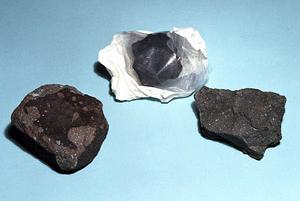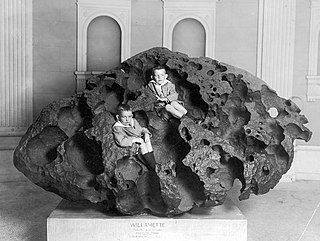
A meteorite is a solid piece of debris from an object, such as a comet, asteroid, or meteoroid, that originates in outer space and survives its passage through the atmosphere to reach the surface of a planet or moon. When the original object enters the atmosphere, various factors such as friction, pressure, and chemical interactions with the atmospheric gases cause it to heat up and radiate energy. It then becomes a meteor and forms a fireball, also known as a shooting star or falling star; astronomers call the brightest examples "bolides". Once it settles on the larger body's surface, the meteor becomes a meteorite. Meteorites vary greatly in size. For geologists, a bolide is a meteorite large enough to create an impact crater.

A Martian meteorite is a rock that formed on Mars, was ejected from the planet by an impact event, and traversed interplanetary space before landing on Earth as a meteorite. As of September 2020, 277 meteorites had been classified as Martian, less than half a percent of the 72,000 meteorites that have been classified. The largest complete, uncut Martian meteorite, Taoudenni 002, was recovered in Mali in early 2021. It weighs 14.5 kilograms and is on display at the Maine Mineral & Gem Museum.

A chondrite is a stony (non-metallic) meteorite that has not been modified, by either melting or differentiation of the parent body. They are formed when various types of dust and small grains in the early Solar System accreted to form primitive asteroids. Some such bodies that are captured in the planet’s gravity well become the most common type of meteorite by arriving on a trajectory toward the Earth’s surface. Estimates for their contribution to the total meteorite population vary between 85.7% and 86.2%.

A micrometeorite is a micrometeoroid that has survived entry through the Earth's atmosphere. Usually found on Earth's surface, micrometeorites differ from meteorites in that they are smaller in size, more abundant, and different in composition. The IAU officially defines meteorites as 30 micrometers to 1 meter; micrometeorites are the small end of the range (~submillimeter). They are a subset of cosmic dust, which also includes the smaller interplanetary dust particles (IDPs).

Meteoric iron, sometimes meteoritic iron, is a native metal and early-universe protoplanetary-disk remnant found in meteorites and made from the elements iron and nickel, mainly in the form of the mineral phases kamacite and taenite. Meteoric iron makes up the bulk of iron meteorites but is also found in other meteorites. Apart from minor amounts of telluric iron, meteoric iron is the only naturally occurring native metal of the element iron on the Earth's surface.
Meteoritics is the science that deals with meteors, meteorites, and meteoroids. It is closely connected to cosmochemistry, mineralogy and geochemistry. A specialist who studies meteoritics is known as a meteoriticist.

Troilite is a rare iron sulfide mineral with the simple formula of FeS. It is the iron-rich endmember of the pyrrhotite group. Pyrrhotite has the formula Fe(1-x)S which is iron deficient. As troilite lacks the iron deficiency which gives pyrrhotite its characteristic magnetism, troilite is non-magnetic.

Vigarano Mainarda is a comune (municipality) in the Province of Ferrara in the Italian region Emilia-Romagna, located about 40 kilometres (25 mi) northeast of Bologna and about 9 kilometres (6 mi) west of Ferrara.

Extraterrestrial material refers to natural objects now on Earth that originated in outer space. Such materials include cosmic dust and meteorites, as well as samples brought to Earth by sample return missions from the Moon, asteroids and comets, as well as solar wind particles.
Aluminium-26 is a radioactive isotope of the chemical element aluminium, decaying by either positron emission or electron capture to stable magnesium-26. The half-life of 26Al is 7.17×105 (717,000) years. This is far too short for the isotope to survive as a primordial nuclide, but a small amount of it is produced by collisions of atoms with cosmic ray protons.

Homestead is a L5 meteorite fallen in 1875 in Iowa, United States.
Astroecology concerns the interactions of biota with space environments. It studies resources for life on planets, asteroids and comets, around various stars, in galaxies, and in the universe. The results allow estimating the future prospects for life, from planetary to galactic and cosmological scales.

CI chondrites, sometimes C1 chondrites, are a group of rare stony meteorites belonging to the carbonaceous chondrites. Samples have been discovered in France, Canada, India, and Tanzania. Compared to all the meteorites found so far, their overall chemical composition most closely resembles the elemental distribution in the sun's photosphere. Currently, borderline CI specimens found in Antarctica may or may not receive their own group, CY chondrites.

Antimatter comets and antimatter meteoroids are hypothetical comets and meteoroids composed solely of antimatter instead of ordinary matter. Although never actually observed, and unlikely to exist anywhere within the Milky Way, they have been hypothesized to exist, and their existence, on the presumption that hypothesis is correct, has been put forward as one possible explanation for various observed natural phenomena over the years.

Meteorite weathering is the terrestrial alteration of a meteorite. Most meteorites date from the oldest times in the Solar System and are by far the oldest material available on our planet. Despite their age, they are vulnerable to the terrestrial environment. Water, chlorine and oxygen attack meteorites as soon as they reach the ground.
The Angra dos Reis meteorite is the type specimen of the angrite group. It was observed when it fell to earth in 1869.

Northwest Africa 7034 is a Martian meteorite believed to be the second oldest yet discovered. It is estimated to be two billion years old and contains the most water of any Martian meteorite found on Earth. Although it is from Mars it does not fit into any of the three SNC meteorite categories, and forms a new Martian meteorite group named "Martian ". Nicknamed "Black Beauty", it was purchased in Morocco and a slice of it was donated to the University of New Mexico by its American owner.
Buena Vista is an unincorporated community in Taylor Township, Harrison County, Indiana, in the United States.
CM chondrites are a group of chondritic meteorites which resemble their type specimen, the Mighei meteorite. The CM is the most commonly recovered group of the 'carbonaceous chondrite' class of meteorites, though all are rarer in collections than ordinary chondrites.
Edward Anders is a Latvian-born American chemist and emeritus professor of chemistry at the University of Chicago. His major areas of research have included the origin and ages of meteorites, the existence of presolar grains in meteorites, the solar-system abundance of chemical elements, and mass extinctions in earth history. In the 1970s, he was one of the 142 principal investigators who studied lunar samples brought back to Earth by the Apollo program. After retiring from scientific research in 1991, he became a prominent researcher, speaker and writer on issues related to the Holocaust in Latvia.













